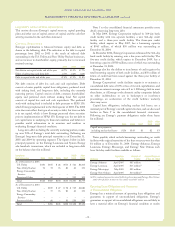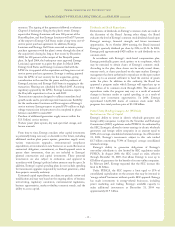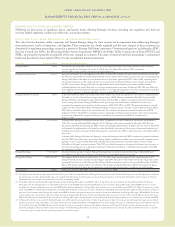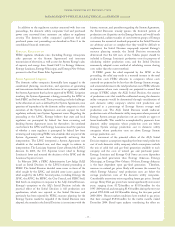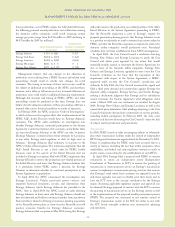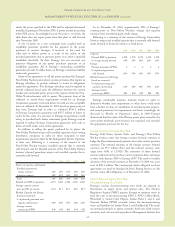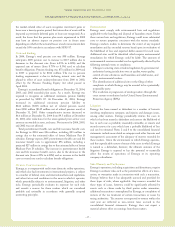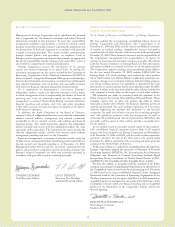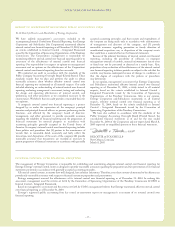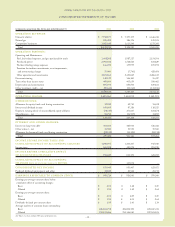Entergy 2004 Annual Report Download - page 40
Download and view the complete annual report
Please find page 40 of the 2004 Entergy annual report below. You can navigate through the pages in the report by either clicking on the pages listed below, or by using the keyword search tool below to find specific information within the annual report.
-38 -
Entergy Corporation and Subsidiaries 2004
power exists.The applicant will then have the opportunity to either:
(1) submit a more detailed market power analysis that reflects
market prices and measures an applicant’s “economic capacity” and
“available economic capacity” under the “delivered price test;” or
(2) propose case-specific mitigation tailored to the applicant’s
specific circumstances or adopt cost-based rates for sales within the
applicant’s control area.
In its April 2004 order, FERC also: (1) determined that
transmission market power and the need to employ an independent
entity to operate and administer an applicant’s OASIS site is more
properly considered in other proceedings, to the extent appropriate,
and would not be considered in evaluating an applicant’s generation
market power for purposes of granting market-based rate authority;
and (2) eliminated the exemption from the generation market
power analysis for sales within an RTO/ISO that had approved
market monitoring. Several parties, including Entergy, filed for
rehearing of the April 2004 order. Among other things, Entergy
argued that the market share screen is overly conservative and over-
states vertically integrated utilities’ ability to exercise market power.
In July 2004, FERC issued an order on rehearing
reaffirming the use of the pivotal supplier and market share screens
and clarified certain instructions for performing suchanalysis.
With regardto the delivered price test analysis, FERC declined
to make a determination on whether an applicant’s native load
obligations will be reflected when evaluating an applicant’s
generationmarket power, but instead indicated that it would
evaluate the arguments of both the applicant and intervenors as to
which measure (one with or without native load obligations) more
accurately reflects market conditions. Entergy appealed the April
2004 and July2004 orders to the United States Courtof Appeals
for the District of Columbia Circuit. In February 2005, the D.C.
Circuit granted FERC’s motion to dismiss Entergy’s appeal on the
grounds that Entergy’s claims were premature. The D.C. Circuit
found that Entergy’s petition was premature because the D.C.
Circuit was not yet in a position to evaluate the manner in which
FERC will apply its new market power tests or whether the tests
will have adverse consequences for Entergy. Thus, the D.C. Circuit
has not ruled on the merits of Entergy’s appeal.
Entergy filed with FERC its generation market power analysis
pursuant to the two indicative screens in August 2004. Entergy’s
analysis indicated that it passed the pivotal supplier screen for all
relevant geographical regions, but failed the market share screen
within its control area. At the same time, Entergy submitted the
results of the delivered price test for Entergy, which indicate that
Entergy does not have market power in any wholesale market when
Entergy’s native load obligations are reflected.
In December 2004, FERC issued an order pursuant to Section
206 of the Federal Power Act: (1) finding that Entergy failed the
market share screen; (2) indicating that FERC is continuing to
review the delivered price test analysis submitted by Entergy;
(3) establishing a refund effective date for Entergy’s market-based
wholesale sales within its control area; and (4) indicating that
FERC believes that it can reach a decision concerning Entergy’s
market-based rate authorityby the second quarter of 2005.
If FERCwere to revoke Entergy’s or the domestic utility
companies’ market-based rate authority for wholesale sales within
the Entergy control area, these entities would be limited to making
wholesale sales pursuant to cost-based rate schedules approved by
FERC. The wholesale sales of the domestic utility companies and
their affiliates, including Entergy’s non-nuclear wholesale assets
business, within the Entergy control area could either be cost-
justified or are of such a limited amount that management does not
believe that the revocation of their market-based rate authority
would have a material effect on the financial results of Entergy.
Because Entergy believes that it does not possess market power and
that FERC’s tests are flawed, Entergy intends to vigorously defend
its market-based rate authority.
FERC has also initiated a rulemaking proceeding to address,
among other things, whether FERC should retain or modify its
existing four-prong test for evaluating market-based rate
applications (i.e., whether the applicant has generation or
transmission market power, whether the applicant can erect barriers
to entry, and whether there are affiliate abuse or reciprocal dealing
concerns), and whether FERC should adopt different approaches
for affiliate transactions. FERC has held a series of technical
conferences to discuss these issues. Additionally, in February 2005,
FERCadopted revised reporting obligations for changes in status
that apply to public utilities authorized to make wholesale sales of
power at market-based rates. FERC determined to replace the
current triennial reporting requirement with more detailed
guidelines concerning the types of events that will trigger a
reporting obligation and the timing and format for such reports.
The new rules willbecome partof allexisting market-based rate
tariffs during March 2005.
Interconnection Orders
The domestic utility companies (except Entergy New Orleans) are
currently defendants to several complaints and rehearing requests
before FERC in which independent generation entities (GenCos)
are seeking a refund of monies that the GenCos had previously paid
to the Entergycompanies for facilities necessary to connect their
generation facilities to Entergy’s transmission system. FERC has
issued initial orders in response to two of the complaints and in
certain other dockets ordering Entergy to refund approximately
$100 million in expenses and tax obligations previously paid by the
GenCos. The refunds will be in the form of transmission credits
that willbe utilized over time as the GenCos take transmission
service from Entergy.
In addition, Entergy Louisiana was recently directed, effective as
of March 2001, to provide transmission credits, with interest,
associated with a specific generator that asserted to FERC that it
retained in its contract for interconnection a right to execute the
latest form of Entergy’s standard interconnection agreement in lieu
of its existing contract, which thereby would apply FERC’s most
recent interconnection cost allocation policies to that generator.
Following an Administrative Law Judge’s (ALJ) Initial Decision
and an order affirming such decision by FERC, approximately
$15 million in expenses and tax obligations previously paid by the
generator have been ordered refunded in the form of transmission
credits, to be utilized over time and applied to Entergytransmission
service bills incurred after March 2001. Entergy has sought
rehearing of the FERC’s order.
MANAGEMENT’S FINANCIAL DISCUSSION and ANALYSIS continued


